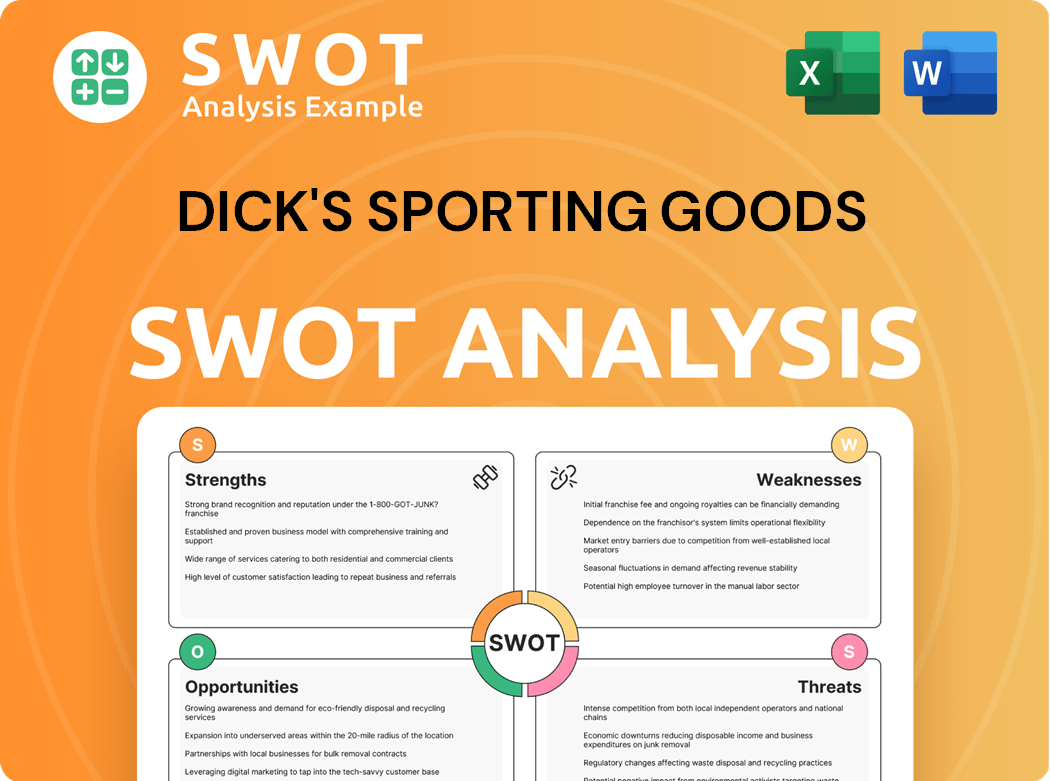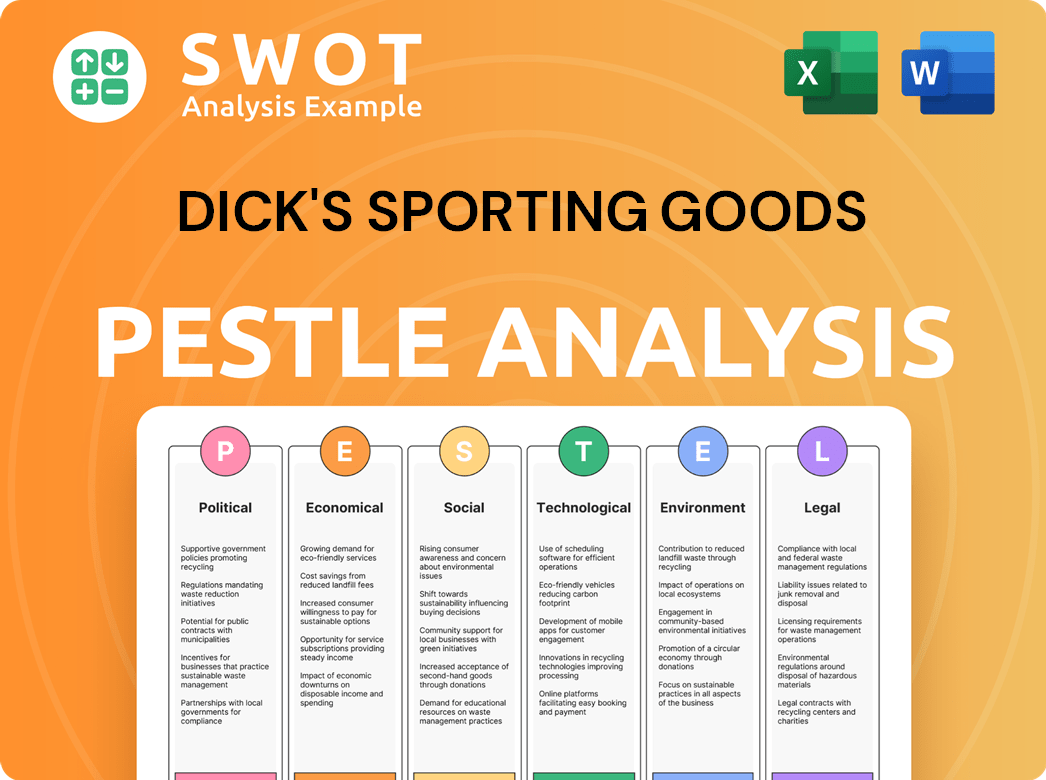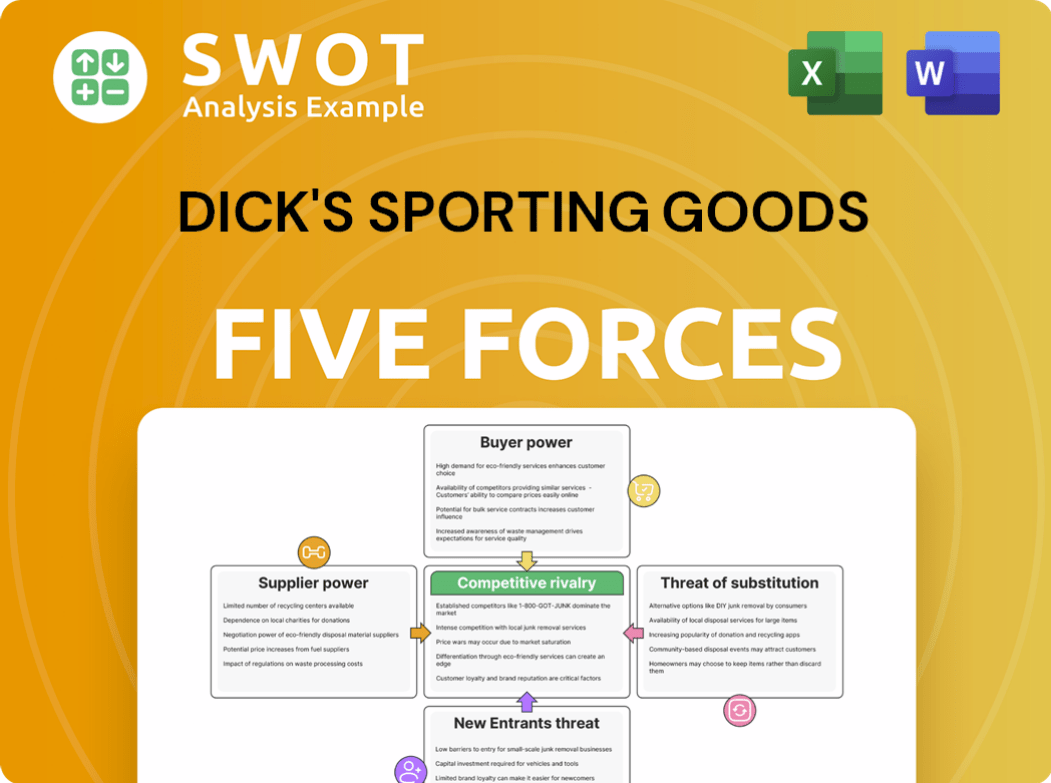Dick's Bundle
How Did Dick's Sporting Goods Go From a Tackle Shop to a Retail Giant?
Ever wonder how a small fishing tackle shop transformed into a leading Dick's Sporting Goods SWOT Analysis? This journey began in 1948 with a simple vision and a $300 investment. From its humble beginnings in Binghamton, New York, to its current status as a dominant force in the sporting goods industry, the

This exploration of
What is the Dick's Sporting Goods Founding Story?
The story of Dick's Sporting Goods, a prominent sporting goods retailer, began in 1948. It all started with Richard 'Dick' Stack, an 18-year-old with a passion for fishing. His entrepreneurial journey laid the groundwork for what would become a major player in the retail industry.
Frustrated by the lack of support for his ideas at his job, Dick decided to take matters into his own hands. With a $300 loan from his grandmother, he set out to create his own business. This initial investment was the seed that would grow into a nationwide chain.
The early days of Dick's Sporting Goods were humble, with a small, local retail shop focused on fishing supplies. Dick's commitment to community and youth sports was evident early on. The company was originally incorporated as Dick's Clothing and Sporting Goods, Inc. in New York.
The brief history of Dick's Sporting Goods company highlights its origins in 1948 with Richard 'Dick' Stack. He started the company with $300 from his grandmother to open a bait-and-tackle shop.
- Dick's Sporting Goods's initial focus was on fishing supplies, catering to local enthusiasts.
- The company's incorporation as Dick's Clothing and Sporting Goods, Inc. in New York marked a formal beginning.
- Dick Stack's community-minded approach, like sponsoring Little League teams, shaped the company's early culture.
- Learn more about the Owners & Shareholders of Dick's Sporting Goods to understand the company's structure.
Dick's SWOT Analysis
- Complete SWOT Breakdown
- Fully Customizable
- Editable in Excel & Word
- Professional Formatting
- Investor-Ready Format

What Drove the Early Growth of Dick's Sporting Goods?
The early growth and expansion of Dick's Sporting Goods marked a pivotal phase in its journey. Initially, the company broadened its offerings beyond its original bait and tackle shop, signaling a strategic shift. Under new leadership, the company experienced significant growth, expanding its store count and market presence. These early moves set the stage for the company's future success as a leading sporting goods retailer.
In the late 1970s, the company expanded its product line to encompass a wider array of sporting goods. This expansion represented a key step in the evolution of the business, moving beyond its initial focus. This diversification laid the groundwork for future growth and a broader customer base.
In 1984, Edward W. Stack and his siblings acquired the business from their father. At that time, the company operated only two small stores in upstate New York. This transition marked a turning point, setting the stage for significant expansion under Ed Stack's leadership.
The company relocated its headquarters to Pittsburgh in 1994, by which time it had grown to 30 stores. This move facilitated better management and logistical capabilities, supporting further growth. This expansion enhanced its market presence.
In 2002, Dick's Sporting Goods went public, providing capital for further expansion and increasing its visibility. The IPO was a crucial step in its financial history, enabling it to fund growth initiatives. This strategic move helped solidify its position in the retail market.
Dick's PESTLE Analysis
- Covers All 6 PESTLE Categories
- No Research Needed – Save Hours of Work
- Built by Experts, Trusted by Consultants
- Instant Download, Ready to Use
- 100% Editable, Fully Customizable

What are the key Milestones in Dick's Sporting Goods history?
The brief history of Dick's Sporting Goods includes several key milestones that have shaped the DSG company into a leading sporting goods retailer. From its humble beginnings to its current status, Dick's Sporting Goods has continually adapted and expanded.
| Year | Milestone |
|---|---|
| 1948 | Richard 'Dick' Stack founded the first store, a bait-and-tackle shop in Binghamton, New York. |
| 1970s | The company expanded, focusing on a broader range of sporting goods. |
| 1990s | Dick's Sporting Goods went public, marking a significant step in its growth. |
| 2000s | The company continued its expansion, acquiring other sporting goods retailers and increasing its store footprint. |
| 2024 | By the end of 2024, the company had opened 19 House of Sport locations and 26 Dick's Field House stores. |
Dick's Sporting Goods has consistently embraced innovation to enhance the customer experience and maintain its competitive edge. One key innovation is the development of experiential retail formats like 'House of Sport' and 'Field House.'
These formats offer immersive experiences such as climbing walls and batting cages. House of Sport locations are expected to generate approximately $35 million in omnichannel sales per store in their first year.
The company is focused on bolstering its e-commerce business and digital experiences. This includes its mobile app and expanding its use of AI in supply chain management.
Dick's is investing in a new 800,000-square-foot distribution center in Fort Worth, Texas. This is expected to open in early 2026 to enhance supply chain efficiency.
The DSG company has also faced various challenges throughout its retail history, including macroeconomic conditions and competitive pressures. However, Dick's Sporting Goods has shown resilience through strategic investments and a focus on customer experience.
The retail industry faces dynamic macroeconomic environments. The company must adapt to changing consumer behaviors and economic fluctuations.
Competition from both online and brick-and-mortar retailers is a constant challenge. Maintaining a strong brand presence and customer loyalty is crucial.
By 2025, Dick's aims to eliminate single-use, point-of-sale plastic bags in all stores. The company also has goals to increase BIPOC representation in leadership by 30% by 2025.
Dick's Business Model Canvas
- Complete 9-Block Business Model Canvas
- Effortlessly Communicate Your Business Strategy
- Investor-Ready BMC Format
- 100% Editable and Customizable
- Clear and Structured Layout

What is the Timeline of Key Events for Dick's Sporting Goods?
The DSG company has a rich Dick's history, starting in 1948 when Richard 'Dick' Stack opened a small bait-and-tackle shop. Over the years, it transformed from a small shop to a leading sporting goods retailer with significant company growth. Key milestones of Dick's Sporting Goods include going public in 2002 and expanding its retail footprint with innovative store concepts like 'House of Sport'.
| Year | Key Event |
|---|---|
| 1948 | Richard Stack opens a bait-and-tackle shop in Binghamton, New York. |
| Late 1970s | The company broadens its product line to include a wider variety of sporting goods. |
| 1984 | Edward W. Stack and his siblings take over the business. |
| 1994 | The company headquarters moves to Pittsburgh, and the store count reaches 30. |
| 2002 | Dick's Sporting Goods goes public on the NYSE (DKS). |
| 2007 | Acquisition of Golf Galaxy. |
| 2012 | The company launches its e-commerce platform. |
| 2021 | The first 'House of Sport' stores open, introducing experiential retail. |
| 2023 | The company celebrates its 75th anniversary. |
| 2024 | Fiscal year ends with record sales of $13.4 billion and 5.2% comparable sales growth. |
In 2025, Dick's Sporting Goods plans to open roughly 16 more 'House of Sport' locations and 18 'Field House' locations. The company is focused on expanding its physical presence and enhancing the customer experience through these innovative store formats. This expansion strategy is key to capturing more market share.
The company anticipates full-year comparable sales growth between 1.0% and 3.0% in 2025, with earnings per diluted share expected to be between $13.80 and $14.40. These financial goals reflect a positive outlook. The company plans to invest approximately $1 billion in capital expenditures.
By 2030, Dick's Sporting Goods aims to decrease its greenhouse gas emissions from operations by 30% compared to the 2016 baseline. This commitment shows the company's dedication to environmental sustainability. The company is actively working towards a more sustainable future.
The company is concentrating on the growth of its footwear category and accelerating its e-commerce capabilities. Major sporting events through 2030 and beyond are expected to boost its market share. The company's omnichannel strategy is crucial for future success.
Dick's Porter's Five Forces Analysis
- Covers All 5 Competitive Forces in Detail
- Structured for Consultants, Students, and Founders
- 100% Editable in Microsoft Word & Excel
- Instant Digital Download – Use Immediately
- Compatible with Mac & PC – Fully Unlocked

Related Blogs
- What is Competitive Landscape of Dick's Sporting Goods Company?
- What is Growth Strategy and Future Prospects of Dick's Sporting Goods Company?
- How Does Dick's Sporting Goods Company Work?
- What is Sales and Marketing Strategy of Dick's Sporting Goods Company?
- What is Brief History of Dick's Sporting Goods Company?
- Who Owns Dick's Sporting Goods Company?
- What is Customer Demographics and Target Market of Dick's Sporting Goods Company?
Disclaimer
All information, articles, and product details provided on this website are for general informational and educational purposes only. We do not claim any ownership over, nor do we intend to infringe upon, any trademarks, copyrights, logos, brand names, or other intellectual property mentioned or depicted on this site. Such intellectual property remains the property of its respective owners, and any references here are made solely for identification or informational purposes, without implying any affiliation, endorsement, or partnership.
We make no representations or warranties, express or implied, regarding the accuracy, completeness, or suitability of any content or products presented. Nothing on this website should be construed as legal, tax, investment, financial, medical, or other professional advice. In addition, no part of this site—including articles or product references—constitutes a solicitation, recommendation, endorsement, advertisement, or offer to buy or sell any securities, franchises, or other financial instruments, particularly in jurisdictions where such activity would be unlawful.
All content is of a general nature and may not address the specific circumstances of any individual or entity. It is not a substitute for professional advice or services. Any actions you take based on the information provided here are strictly at your own risk. You accept full responsibility for any decisions or outcomes arising from your use of this website and agree to release us from any liability in connection with your use of, or reliance upon, the content or products found herein.